Masters in Early Childhood: Observation and Play Analysis Report
VerifiedAdded on 2022/08/22
|13
|3974
|19
Report
AI Summary
This report presents an analysis of observations conducted on infants, toddlers, and young children within an early childhood education (ECE) context. The observations, utilizing various techniques such as interval recording, duration recording, and narrative, are centered on children's play behaviors. The report delves into the significance of play in early childhood development, highlighting how children explore their environment, develop social and cognitive skills, and express their emotions through play. The analysis connects observed behaviors with relevant aspects of learning, including the development of language, social interaction, problem-solving abilities, and the influence of the Early Years Learning Framework (EYLF). The study also explores how children's play evolves with age, with specific examples of how infants, toddlers, and children above three years engage in different types of play. The report emphasizes the importance of educators' observations in understanding a child's individual development, and how play supports the development of social skills, communication skills, and imagination.
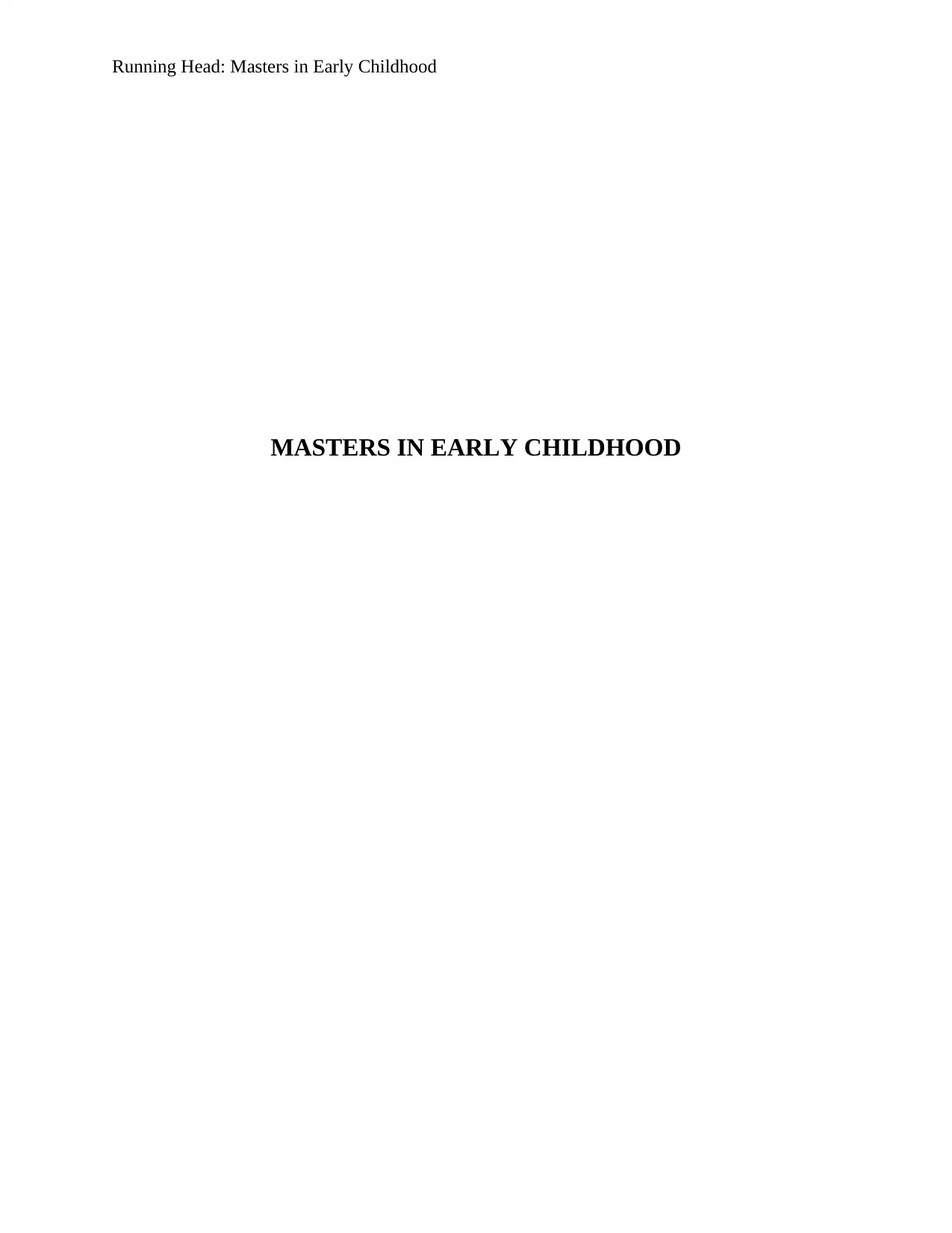
Running Head: Masters in Early Childhood
MASTERS IN EARLY CHILDHOOD
MASTERS IN EARLY CHILDHOOD
Paraphrase This Document
Need a fresh take? Get an instant paraphrase of this document with our AI Paraphraser
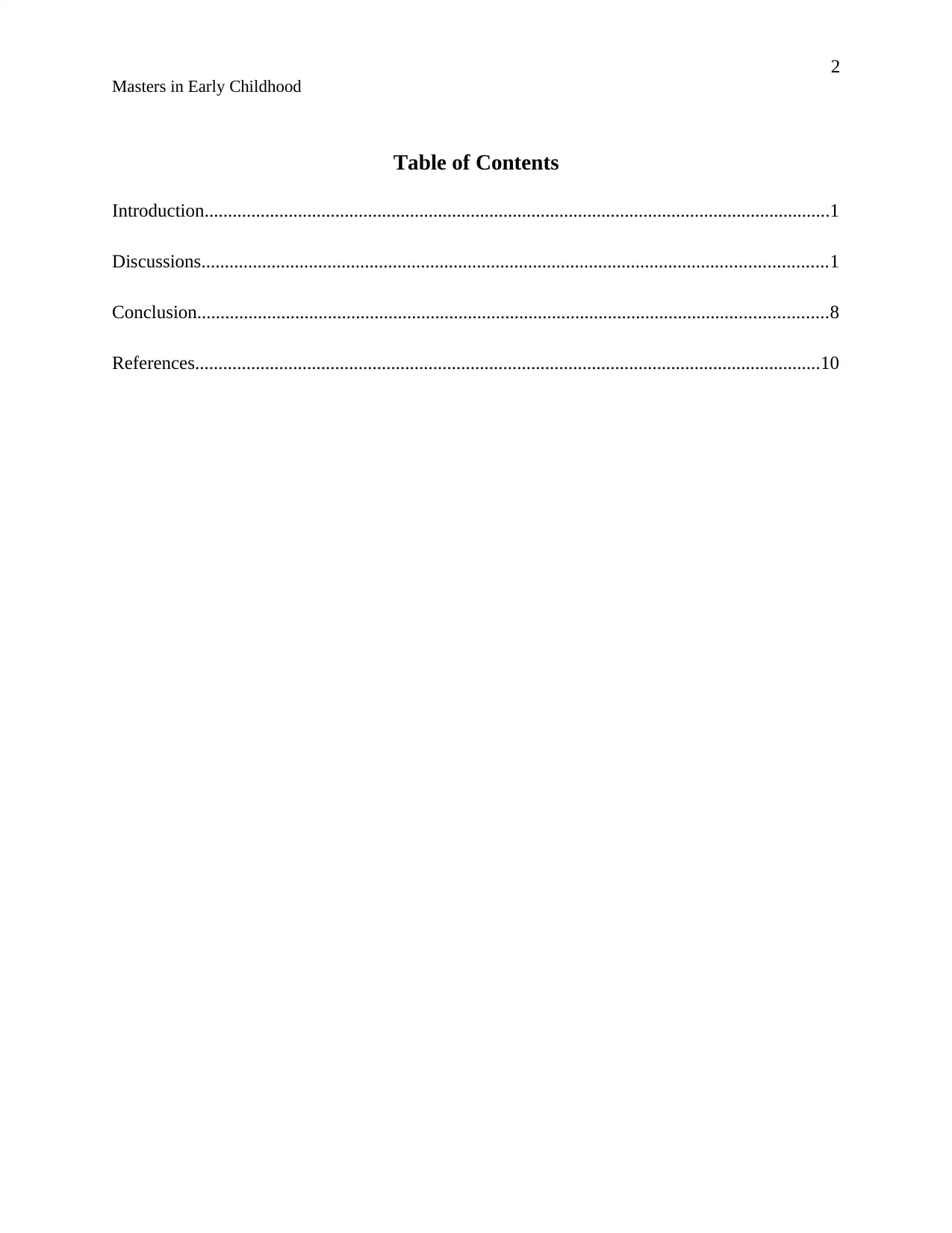
2
Masters in Early Childhood
Table of Contents
Introduction......................................................................................................................................1
Discussions......................................................................................................................................1
Conclusion.......................................................................................................................................8
References......................................................................................................................................10
Masters in Early Childhood
Table of Contents
Introduction......................................................................................................................................1
Discussions......................................................................................................................................1
Conclusion.......................................................................................................................................8
References......................................................................................................................................10
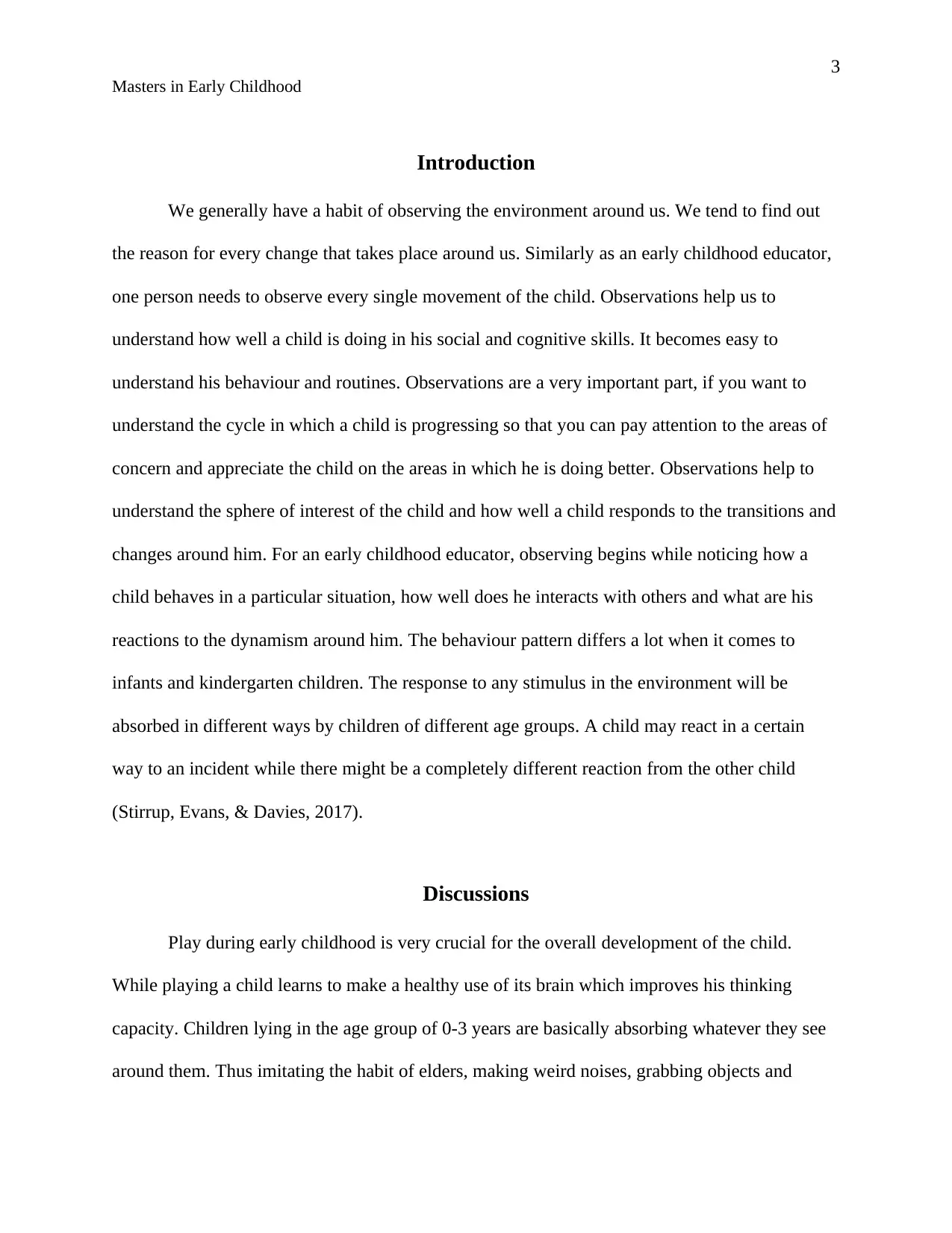
3
Masters in Early Childhood
Introduction
We generally have a habit of observing the environment around us. We tend to find out
the reason for every change that takes place around us. Similarly as an early childhood educator,
one person needs to observe every single movement of the child. Observations help us to
understand how well a child is doing in his social and cognitive skills. It becomes easy to
understand his behaviour and routines. Observations are a very important part, if you want to
understand the cycle in which a child is progressing so that you can pay attention to the areas of
concern and appreciate the child on the areas in which he is doing better. Observations help to
understand the sphere of interest of the child and how well a child responds to the transitions and
changes around him. For an early childhood educator, observing begins while noticing how a
child behaves in a particular situation, how well does he interacts with others and what are his
reactions to the dynamism around him. The behaviour pattern differs a lot when it comes to
infants and kindergarten children. The response to any stimulus in the environment will be
absorbed in different ways by children of different age groups. A child may react in a certain
way to an incident while there might be a completely different reaction from the other child
(Stirrup, Evans, & Davies, 2017).
Discussions
Play during early childhood is very crucial for the overall development of the child.
While playing a child learns to make a healthy use of its brain which improves his thinking
capacity. Children lying in the age group of 0-3 years are basically absorbing whatever they see
around them. Thus imitating the habit of elders, making weird noises, grabbing objects and
Masters in Early Childhood
Introduction
We generally have a habit of observing the environment around us. We tend to find out
the reason for every change that takes place around us. Similarly as an early childhood educator,
one person needs to observe every single movement of the child. Observations help us to
understand how well a child is doing in his social and cognitive skills. It becomes easy to
understand his behaviour and routines. Observations are a very important part, if you want to
understand the cycle in which a child is progressing so that you can pay attention to the areas of
concern and appreciate the child on the areas in which he is doing better. Observations help to
understand the sphere of interest of the child and how well a child responds to the transitions and
changes around him. For an early childhood educator, observing begins while noticing how a
child behaves in a particular situation, how well does he interacts with others and what are his
reactions to the dynamism around him. The behaviour pattern differs a lot when it comes to
infants and kindergarten children. The response to any stimulus in the environment will be
absorbed in different ways by children of different age groups. A child may react in a certain
way to an incident while there might be a completely different reaction from the other child
(Stirrup, Evans, & Davies, 2017).
Discussions
Play during early childhood is very crucial for the overall development of the child.
While playing a child learns to make a healthy use of its brain which improves his thinking
capacity. Children lying in the age group of 0-3 years are basically absorbing whatever they see
around them. Thus imitating the habit of elders, making weird noises, grabbing objects and
⊘ This is a preview!⊘
Do you want full access?
Subscribe today to unlock all pages.

Trusted by 1+ million students worldwide
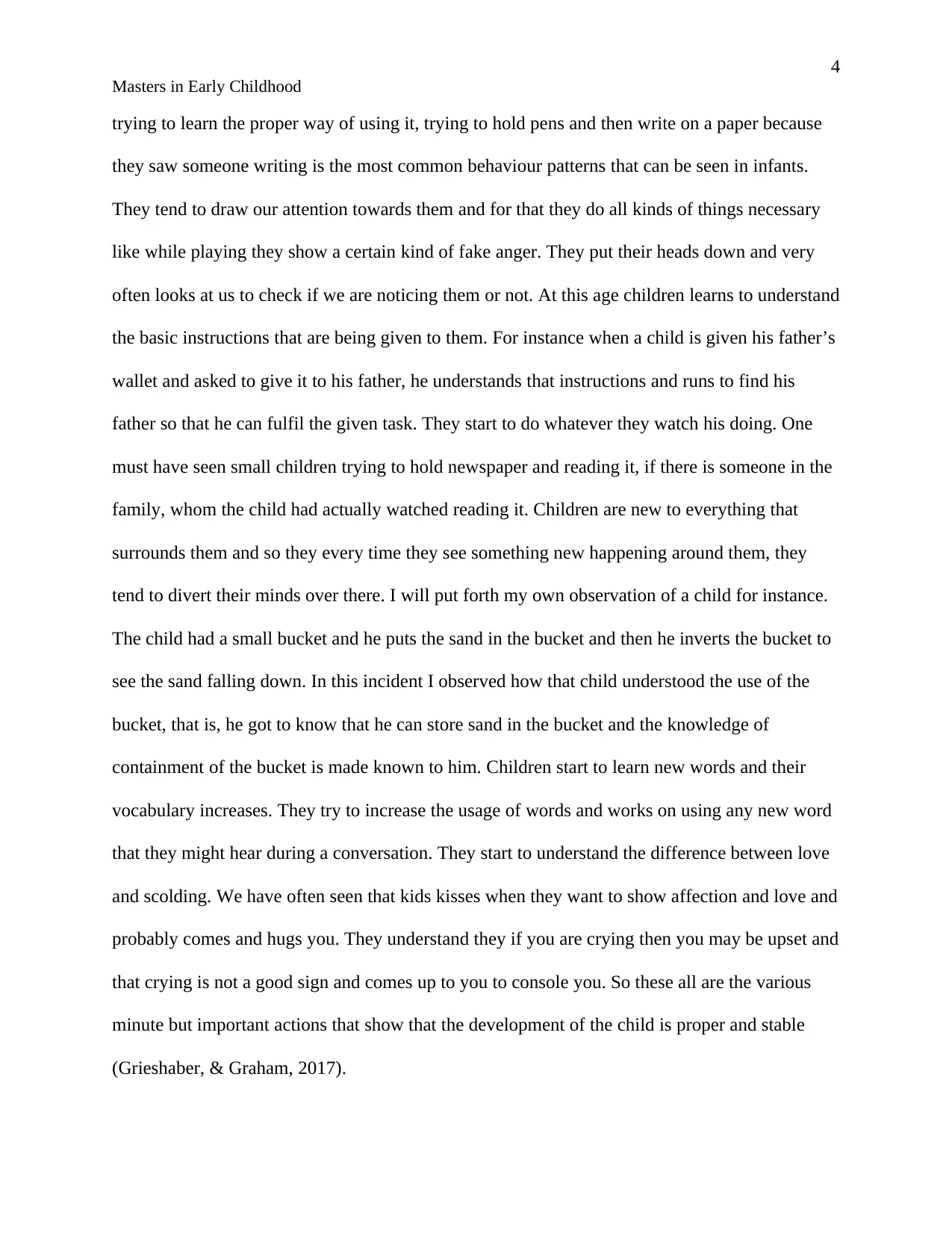
4
Masters in Early Childhood
trying to learn the proper way of using it, trying to hold pens and then write on a paper because
they saw someone writing is the most common behaviour patterns that can be seen in infants.
They tend to draw our attention towards them and for that they do all kinds of things necessary
like while playing they show a certain kind of fake anger. They put their heads down and very
often looks at us to check if we are noticing them or not. At this age children learns to understand
the basic instructions that are being given to them. For instance when a child is given his father’s
wallet and asked to give it to his father, he understands that instructions and runs to find his
father so that he can fulfil the given task. They start to do whatever they watch his doing. One
must have seen small children trying to hold newspaper and reading it, if there is someone in the
family, whom the child had actually watched reading it. Children are new to everything that
surrounds them and so they every time they see something new happening around them, they
tend to divert their minds over there. I will put forth my own observation of a child for instance.
The child had a small bucket and he puts the sand in the bucket and then he inverts the bucket to
see the sand falling down. In this incident I observed how that child understood the use of the
bucket, that is, he got to know that he can store sand in the bucket and the knowledge of
containment of the bucket is made known to him. Children start to learn new words and their
vocabulary increases. They try to increase the usage of words and works on using any new word
that they might hear during a conversation. They start to understand the difference between love
and scolding. We have often seen that kids kisses when they want to show affection and love and
probably comes and hugs you. They understand they if you are crying then you may be upset and
that crying is not a good sign and comes up to you to console you. So these all are the various
minute but important actions that show that the development of the child is proper and stable
(Grieshaber, & Graham, 2017).
Masters in Early Childhood
trying to learn the proper way of using it, trying to hold pens and then write on a paper because
they saw someone writing is the most common behaviour patterns that can be seen in infants.
They tend to draw our attention towards them and for that they do all kinds of things necessary
like while playing they show a certain kind of fake anger. They put their heads down and very
often looks at us to check if we are noticing them or not. At this age children learns to understand
the basic instructions that are being given to them. For instance when a child is given his father’s
wallet and asked to give it to his father, he understands that instructions and runs to find his
father so that he can fulfil the given task. They start to do whatever they watch his doing. One
must have seen small children trying to hold newspaper and reading it, if there is someone in the
family, whom the child had actually watched reading it. Children are new to everything that
surrounds them and so they every time they see something new happening around them, they
tend to divert their minds over there. I will put forth my own observation of a child for instance.
The child had a small bucket and he puts the sand in the bucket and then he inverts the bucket to
see the sand falling down. In this incident I observed how that child understood the use of the
bucket, that is, he got to know that he can store sand in the bucket and the knowledge of
containment of the bucket is made known to him. Children start to learn new words and their
vocabulary increases. They try to increase the usage of words and works on using any new word
that they might hear during a conversation. They start to understand the difference between love
and scolding. We have often seen that kids kisses when they want to show affection and love and
probably comes and hugs you. They understand they if you are crying then you may be upset and
that crying is not a good sign and comes up to you to console you. So these all are the various
minute but important actions that show that the development of the child is proper and stable
(Grieshaber, & Graham, 2017).
Paraphrase This Document
Need a fresh take? Get an instant paraphrase of this document with our AI Paraphraser
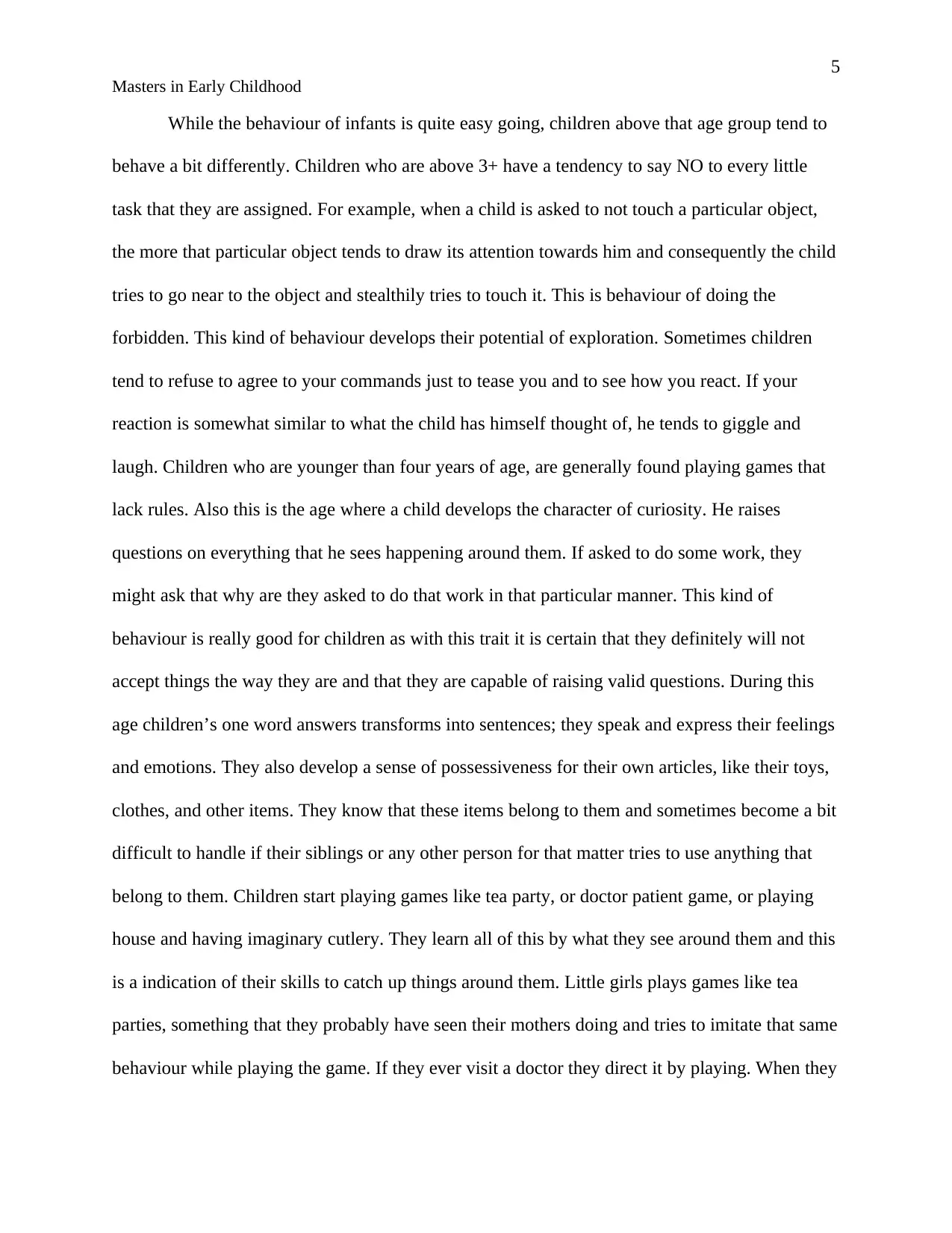
5
Masters in Early Childhood
While the behaviour of infants is quite easy going, children above that age group tend to
behave a bit differently. Children who are above 3+ have a tendency to say NO to every little
task that they are assigned. For example, when a child is asked to not touch a particular object,
the more that particular object tends to draw its attention towards him and consequently the child
tries to go near to the object and stealthily tries to touch it. This is behaviour of doing the
forbidden. This kind of behaviour develops their potential of exploration. Sometimes children
tend to refuse to agree to your commands just to tease you and to see how you react. If your
reaction is somewhat similar to what the child has himself thought of, he tends to giggle and
laugh. Children who are younger than four years of age, are generally found playing games that
lack rules. Also this is the age where a child develops the character of curiosity. He raises
questions on everything that he sees happening around them. If asked to do some work, they
might ask that why are they asked to do that work in that particular manner. This kind of
behaviour is really good for children as with this trait it is certain that they definitely will not
accept things the way they are and that they are capable of raising valid questions. During this
age children’s one word answers transforms into sentences; they speak and express their feelings
and emotions. They also develop a sense of possessiveness for their own articles, like their toys,
clothes, and other items. They know that these items belong to them and sometimes become a bit
difficult to handle if their siblings or any other person for that matter tries to use anything that
belong to them. Children start playing games like tea party, or doctor patient game, or playing
house and having imaginary cutlery. They learn all of this by what they see around them and this
is a indication of their skills to catch up things around them. Little girls plays games like tea
parties, something that they probably have seen their mothers doing and tries to imitate that same
behaviour while playing the game. If they ever visit a doctor they direct it by playing. When they
Masters in Early Childhood
While the behaviour of infants is quite easy going, children above that age group tend to
behave a bit differently. Children who are above 3+ have a tendency to say NO to every little
task that they are assigned. For example, when a child is asked to not touch a particular object,
the more that particular object tends to draw its attention towards him and consequently the child
tries to go near to the object and stealthily tries to touch it. This is behaviour of doing the
forbidden. This kind of behaviour develops their potential of exploration. Sometimes children
tend to refuse to agree to your commands just to tease you and to see how you react. If your
reaction is somewhat similar to what the child has himself thought of, he tends to giggle and
laugh. Children who are younger than four years of age, are generally found playing games that
lack rules. Also this is the age where a child develops the character of curiosity. He raises
questions on everything that he sees happening around them. If asked to do some work, they
might ask that why are they asked to do that work in that particular manner. This kind of
behaviour is really good for children as with this trait it is certain that they definitely will not
accept things the way they are and that they are capable of raising valid questions. During this
age children’s one word answers transforms into sentences; they speak and express their feelings
and emotions. They also develop a sense of possessiveness for their own articles, like their toys,
clothes, and other items. They know that these items belong to them and sometimes become a bit
difficult to handle if their siblings or any other person for that matter tries to use anything that
belong to them. Children start playing games like tea party, or doctor patient game, or playing
house and having imaginary cutlery. They learn all of this by what they see around them and this
is a indication of their skills to catch up things around them. Little girls plays games like tea
parties, something that they probably have seen their mothers doing and tries to imitate that same
behaviour while playing the game. If they ever visit a doctor they direct it by playing. When they
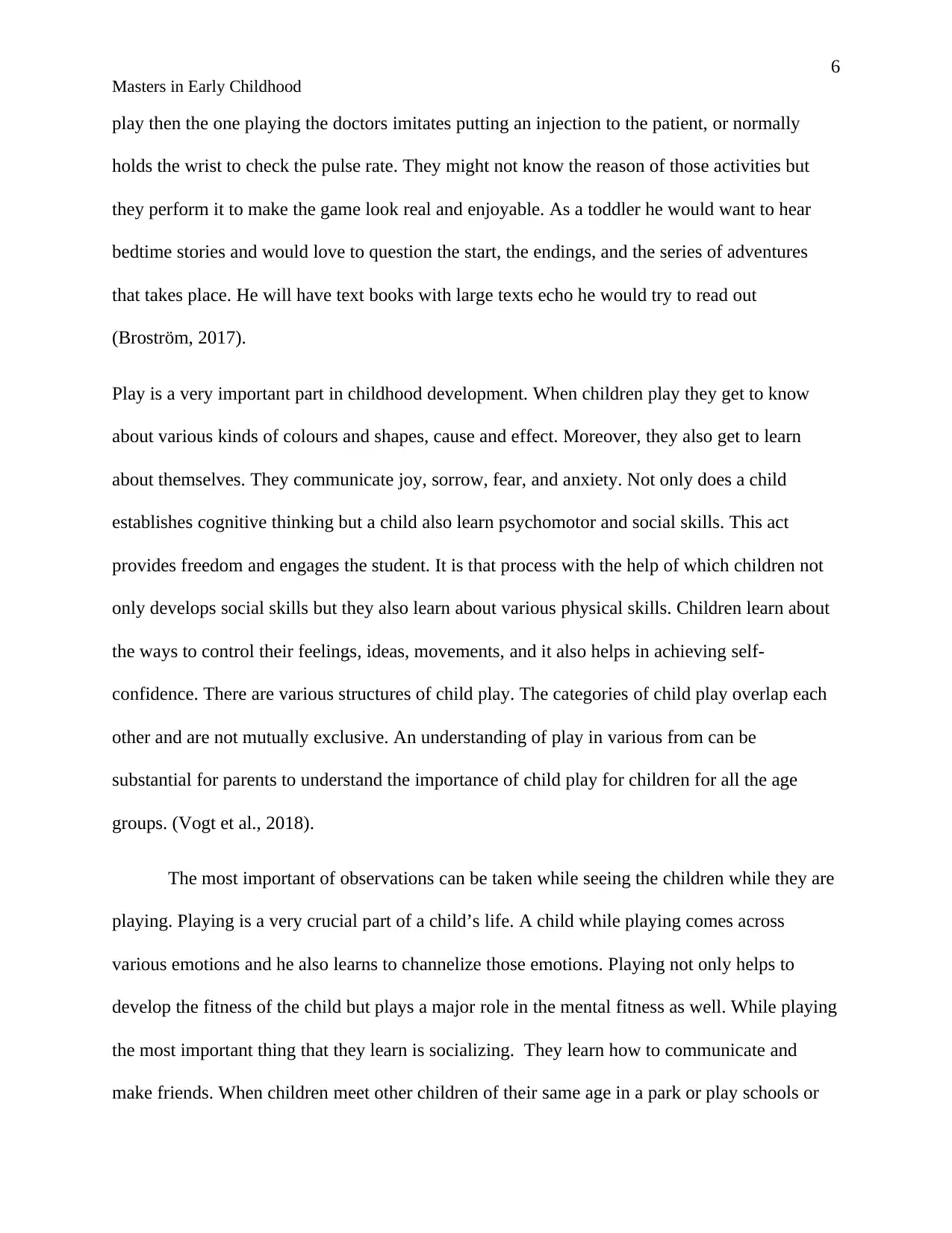
6
Masters in Early Childhood
play then the one playing the doctors imitates putting an injection to the patient, or normally
holds the wrist to check the pulse rate. They might not know the reason of those activities but
they perform it to make the game look real and enjoyable. As a toddler he would want to hear
bedtime stories and would love to question the start, the endings, and the series of adventures
that takes place. He will have text books with large texts echo he would try to read out
(Broström, 2017).
Play is a very important part in childhood development. When children play they get to know
about various kinds of colours and shapes, cause and effect. Moreover, they also get to learn
about themselves. They communicate joy, sorrow, fear, and anxiety. Not only does a child
establishes cognitive thinking but a child also learn psychomotor and social skills. This act
provides freedom and engages the student. It is that process with the help of which children not
only develops social skills but they also learn about various physical skills. Children learn about
the ways to control their feelings, ideas, movements, and it also helps in achieving self-
confidence. There are various structures of child play. The categories of child play overlap each
other and are not mutually exclusive. An understanding of play in various from can be
substantial for parents to understand the importance of child play for children for all the age
groups. (Vogt et al., 2018).
The most important of observations can be taken while seeing the children while they are
playing. Playing is a very crucial part of a child’s life. A child while playing comes across
various emotions and he also learns to channelize those emotions. Playing not only helps to
develop the fitness of the child but plays a major role in the mental fitness as well. While playing
the most important thing that they learn is socializing. They learn how to communicate and
make friends. When children meet other children of their same age in a park or play schools or
Masters in Early Childhood
play then the one playing the doctors imitates putting an injection to the patient, or normally
holds the wrist to check the pulse rate. They might not know the reason of those activities but
they perform it to make the game look real and enjoyable. As a toddler he would want to hear
bedtime stories and would love to question the start, the endings, and the series of adventures
that takes place. He will have text books with large texts echo he would try to read out
(Broström, 2017).
Play is a very important part in childhood development. When children play they get to know
about various kinds of colours and shapes, cause and effect. Moreover, they also get to learn
about themselves. They communicate joy, sorrow, fear, and anxiety. Not only does a child
establishes cognitive thinking but a child also learn psychomotor and social skills. This act
provides freedom and engages the student. It is that process with the help of which children not
only develops social skills but they also learn about various physical skills. Children learn about
the ways to control their feelings, ideas, movements, and it also helps in achieving self-
confidence. There are various structures of child play. The categories of child play overlap each
other and are not mutually exclusive. An understanding of play in various from can be
substantial for parents to understand the importance of child play for children for all the age
groups. (Vogt et al., 2018).
The most important of observations can be taken while seeing the children while they are
playing. Playing is a very crucial part of a child’s life. A child while playing comes across
various emotions and he also learns to channelize those emotions. Playing not only helps to
develop the fitness of the child but plays a major role in the mental fitness as well. While playing
the most important thing that they learn is socializing. They learn how to communicate and
make friends. When children meet other children of their same age in a park or play schools or
⊘ This is a preview!⊘
Do you want full access?
Subscribe today to unlock all pages.

Trusted by 1+ million students worldwide
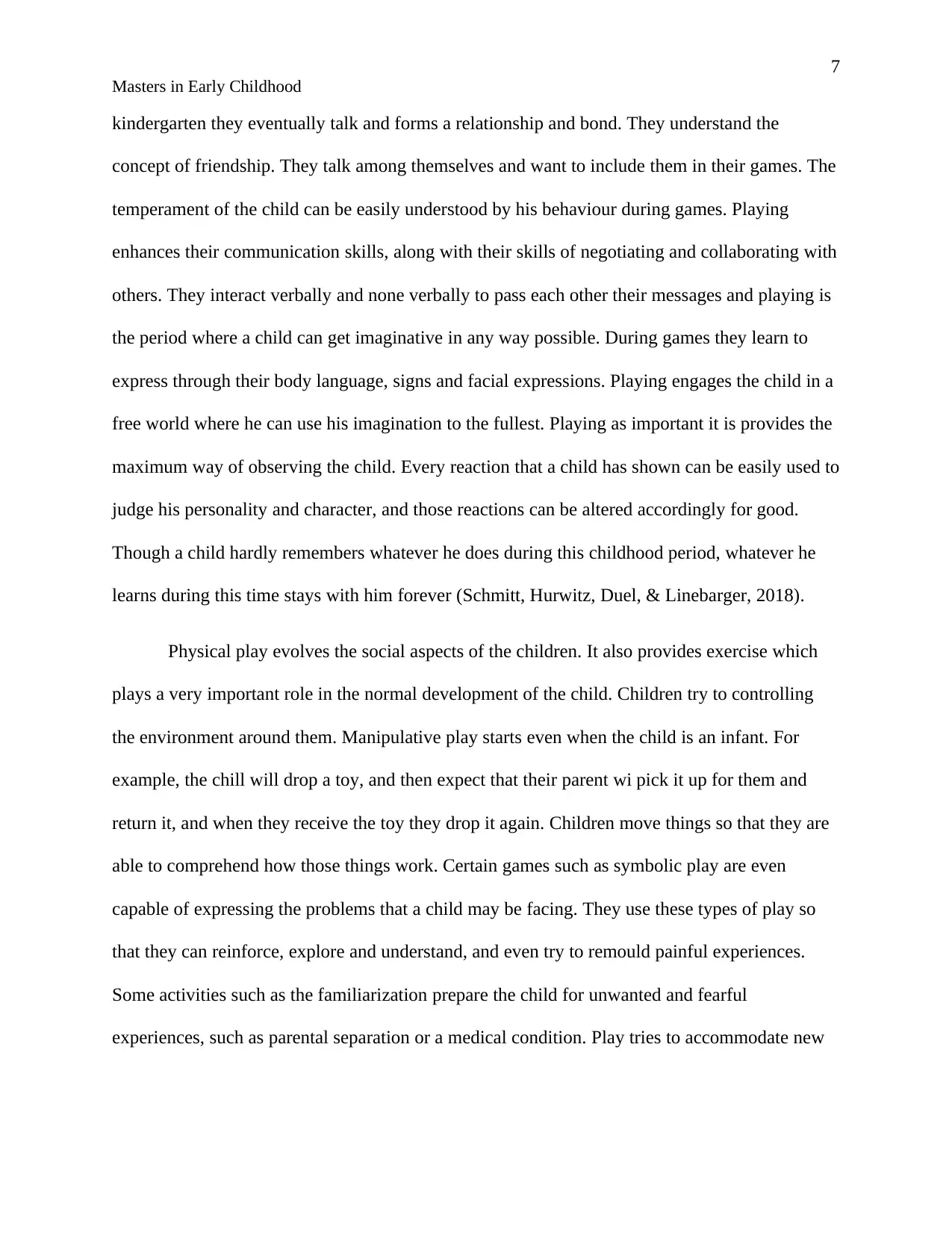
7
Masters in Early Childhood
kindergarten they eventually talk and forms a relationship and bond. They understand the
concept of friendship. They talk among themselves and want to include them in their games. The
temperament of the child can be easily understood by his behaviour during games. Playing
enhances their communication skills, along with their skills of negotiating and collaborating with
others. They interact verbally and none verbally to pass each other their messages and playing is
the period where a child can get imaginative in any way possible. During games they learn to
express through their body language, signs and facial expressions. Playing engages the child in a
free world where he can use his imagination to the fullest. Playing as important it is provides the
maximum way of observing the child. Every reaction that a child has shown can be easily used to
judge his personality and character, and those reactions can be altered accordingly for good.
Though a child hardly remembers whatever he does during this childhood period, whatever he
learns during this time stays with him forever (Schmitt, Hurwitz, Duel, & Linebarger, 2018).
Physical play evolves the social aspects of the children. It also provides exercise which
plays a very important role in the normal development of the child. Children try to controlling
the environment around them. Manipulative play starts even when the child is an infant. For
example, the chill will drop a toy, and then expect that their parent wi pick it up for them and
return it, and when they receive the toy they drop it again. Children move things so that they are
able to comprehend how those things work. Certain games such as symbolic play are even
capable of expressing the problems that a child may be facing. They use these types of play so
that they can reinforce, explore and understand, and even try to remould painful experiences.
Some activities such as the familiarization prepare the child for unwanted and fearful
experiences, such as parental separation or a medical condition. Play tries to accommodate new
Masters in Early Childhood
kindergarten they eventually talk and forms a relationship and bond. They understand the
concept of friendship. They talk among themselves and want to include them in their games. The
temperament of the child can be easily understood by his behaviour during games. Playing
enhances their communication skills, along with their skills of negotiating and collaborating with
others. They interact verbally and none verbally to pass each other their messages and playing is
the period where a child can get imaginative in any way possible. During games they learn to
express through their body language, signs and facial expressions. Playing engages the child in a
free world where he can use his imagination to the fullest. Playing as important it is provides the
maximum way of observing the child. Every reaction that a child has shown can be easily used to
judge his personality and character, and those reactions can be altered accordingly for good.
Though a child hardly remembers whatever he does during this childhood period, whatever he
learns during this time stays with him forever (Schmitt, Hurwitz, Duel, & Linebarger, 2018).
Physical play evolves the social aspects of the children. It also provides exercise which
plays a very important role in the normal development of the child. Children try to controlling
the environment around them. Manipulative play starts even when the child is an infant. For
example, the chill will drop a toy, and then expect that their parent wi pick it up for them and
return it, and when they receive the toy they drop it again. Children move things so that they are
able to comprehend how those things work. Certain games such as symbolic play are even
capable of expressing the problems that a child may be facing. They use these types of play so
that they can reinforce, explore and understand, and even try to remould painful experiences.
Some activities such as the familiarization prepare the child for unwanted and fearful
experiences, such as parental separation or a medical condition. Play tries to accommodate new
Paraphrase This Document
Need a fresh take? Get an instant paraphrase of this document with our AI Paraphraser
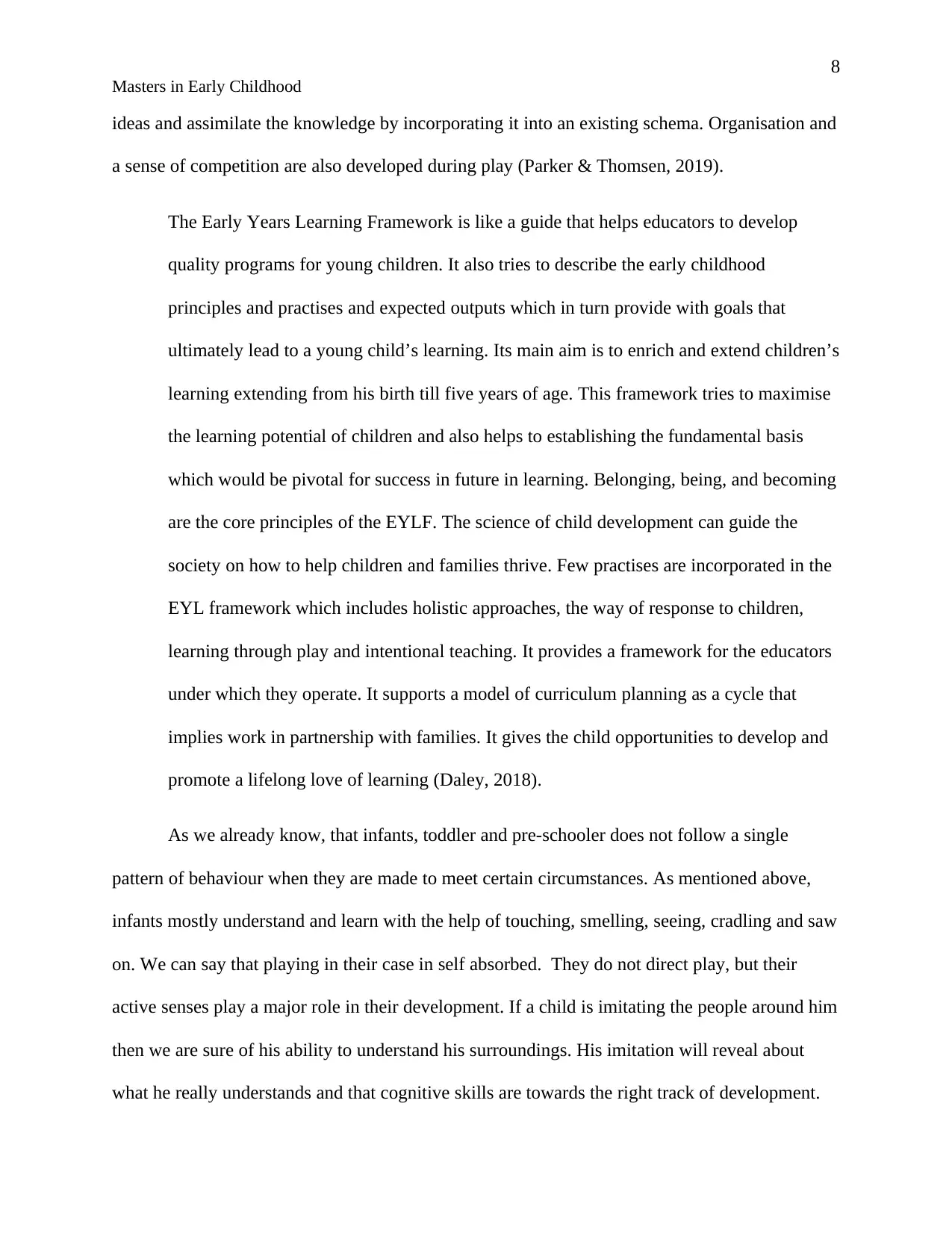
8
Masters in Early Childhood
ideas and assimilate the knowledge by incorporating it into an existing schema. Organisation and
a sense of competition are also developed during play (Parker & Thomsen, 2019).
The Early Years Learning Framework is like a guide that helps educators to develop
quality programs for young children. It also tries to describe the early childhood
principles and practises and expected outputs which in turn provide with goals that
ultimately lead to a young child’s learning. Its main aim is to enrich and extend children’s
learning extending from his birth till five years of age. This framework tries to maximise
the learning potential of children and also helps to establishing the fundamental basis
which would be pivotal for success in future in learning. Belonging, being, and becoming
are the core principles of the EYLF. The science of child development can guide the
society on how to help children and families thrive. Few practises are incorporated in the
EYL framework which includes holistic approaches, the way of response to children,
learning through play and intentional teaching. It provides a framework for the educators
under which they operate. It supports a model of curriculum planning as a cycle that
implies work in partnership with families. It gives the child opportunities to develop and
promote a lifelong love of learning (Daley, 2018).
As we already know, that infants, toddler and pre-schooler does not follow a single
pattern of behaviour when they are made to meet certain circumstances. As mentioned above,
infants mostly understand and learn with the help of touching, smelling, seeing, cradling and saw
on. We can say that playing in their case in self absorbed. They do not direct play, but their
active senses play a major role in their development. If a child is imitating the people around him
then we are sure of his ability to understand his surroundings. His imitation will reveal about
what he really understands and that cognitive skills are towards the right track of development.
Masters in Early Childhood
ideas and assimilate the knowledge by incorporating it into an existing schema. Organisation and
a sense of competition are also developed during play (Parker & Thomsen, 2019).
The Early Years Learning Framework is like a guide that helps educators to develop
quality programs for young children. It also tries to describe the early childhood
principles and practises and expected outputs which in turn provide with goals that
ultimately lead to a young child’s learning. Its main aim is to enrich and extend children’s
learning extending from his birth till five years of age. This framework tries to maximise
the learning potential of children and also helps to establishing the fundamental basis
which would be pivotal for success in future in learning. Belonging, being, and becoming
are the core principles of the EYLF. The science of child development can guide the
society on how to help children and families thrive. Few practises are incorporated in the
EYL framework which includes holistic approaches, the way of response to children,
learning through play and intentional teaching. It provides a framework for the educators
under which they operate. It supports a model of curriculum planning as a cycle that
implies work in partnership with families. It gives the child opportunities to develop and
promote a lifelong love of learning (Daley, 2018).
As we already know, that infants, toddler and pre-schooler does not follow a single
pattern of behaviour when they are made to meet certain circumstances. As mentioned above,
infants mostly understand and learn with the help of touching, smelling, seeing, cradling and saw
on. We can say that playing in their case in self absorbed. They do not direct play, but their
active senses play a major role in their development. If a child is imitating the people around him
then we are sure of his ability to understand his surroundings. His imitation will reveal about
what he really understands and that cognitive skills are towards the right track of development.

9
Masters in Early Childhood
Children tend to become aggressive as they grow up and want things to be done their way.
Though it is quite easy to fool a child, but the way they remember stuffs is incredible. We have
often seen a child with cell phone, putting it on his years, and sometimes even holding it between
his shoulder and ear. If we think about how he learned to do this thing, the answer is very
obvious. At first we might think that the child sees and understands that the cell phone is
something with which we communicate but keeping it between his shoulder and ear makes it
very clear that he learns what he sees. Thus it is very important to make a child learn through
playing. Learning while playing helps to put a deeper impact on the overall development of a
child (Black et al., 2017).
Children are very much sensitive towards the feeling of love and hate. They understand
very quickly that the person around him loves him or not and accordingly is his reaction to the
person. This is the kind of learning that he learns when he comes in contact with a larger crowd.
Thus it is important to match the child's level of sensitivity. Children learn better when they are
praised and appreciated. So an educator must make sure that every time a child does some
progress or does something good, he needs to be appreciated. In that way he would know that
whatever he is doing is correct and that he should do more it to get more praises and love. This
makes the child ready to respond in his already created environment (Devercelli, 2017).
As a child grows, he might also develop a sense of jealousy or dislike towards someone
or something. This would be the time where he would not require your scolding and punishment
but will look for empathy in your behaviour. You need to make the child enough comfortable
with you, so that he is able to share his feelings about things going around him. A child asking
normal and random questions about things around must not he ignored. Rather they must be
provided with proper answers to each question. This will help in increasing his knowledge about
Masters in Early Childhood
Children tend to become aggressive as they grow up and want things to be done their way.
Though it is quite easy to fool a child, but the way they remember stuffs is incredible. We have
often seen a child with cell phone, putting it on his years, and sometimes even holding it between
his shoulder and ear. If we think about how he learned to do this thing, the answer is very
obvious. At first we might think that the child sees and understands that the cell phone is
something with which we communicate but keeping it between his shoulder and ear makes it
very clear that he learns what he sees. Thus it is very important to make a child learn through
playing. Learning while playing helps to put a deeper impact on the overall development of a
child (Black et al., 2017).
Children are very much sensitive towards the feeling of love and hate. They understand
very quickly that the person around him loves him or not and accordingly is his reaction to the
person. This is the kind of learning that he learns when he comes in contact with a larger crowd.
Thus it is important to match the child's level of sensitivity. Children learn better when they are
praised and appreciated. So an educator must make sure that every time a child does some
progress or does something good, he needs to be appreciated. In that way he would know that
whatever he is doing is correct and that he should do more it to get more praises and love. This
makes the child ready to respond in his already created environment (Devercelli, 2017).
As a child grows, he might also develop a sense of jealousy or dislike towards someone
or something. This would be the time where he would not require your scolding and punishment
but will look for empathy in your behaviour. You need to make the child enough comfortable
with you, so that he is able to share his feelings about things going around him. A child asking
normal and random questions about things around must not he ignored. Rather they must be
provided with proper answers to each question. This will help in increasing his knowledge about
⊘ This is a preview!⊘
Do you want full access?
Subscribe today to unlock all pages.

Trusted by 1+ million students worldwide

10
Masters in Early Childhood
stuffs and will broaden his area of thinking. The more he thinks, the better he gets at imagining
stuffs. It becomes important as this would directly impact his creative mind. The way a child
plays with the toys around him also gives a sense of how far has he been able to understand those
toys. Different children will try to play with the same toy in a different way, and their manner of
using that toy will gives a deep sense of knowledge of his creativity and his power of thought. A
toddler learns to identify words, increase his vocabulary, learns to memorize rhymes and even
perform simple mathematical calculations. All these are stages of his development. When he
engages himself into hearing your nap stories, he thinks about the various possibilities of the
things happening in that story and somehow believes it to be true. This is when he tries to
implement these stories in its real life. This would make him understand the relevance of these
stories in the real world. Thus every tiny bit of work in the environment will help a child learn
more and more about his physical, mental and other cognitive skills (Dunn, 2017).
An early childhood study degree is the one which helps to develop special skills and
knowledge around the subject of how children grow and develop. This type of degree gives us a
chance to learn the various specific tools that might help a child in learning, which would be
beneficial for the child in future. The first five years of a child is pivotal for his long term
success and you can be a part of it by having this early childhood study degree. The early years
of a child is very important for his logical proficiency because critical aspects of social,
emotional and cognitive development that stays with the child for his or her entire lifetime are
established during this time period. Thus it is very important to have highly skilled people who
can measure up to the task.
Masters in Early Childhood
stuffs and will broaden his area of thinking. The more he thinks, the better he gets at imagining
stuffs. It becomes important as this would directly impact his creative mind. The way a child
plays with the toys around him also gives a sense of how far has he been able to understand those
toys. Different children will try to play with the same toy in a different way, and their manner of
using that toy will gives a deep sense of knowledge of his creativity and his power of thought. A
toddler learns to identify words, increase his vocabulary, learns to memorize rhymes and even
perform simple mathematical calculations. All these are stages of his development. When he
engages himself into hearing your nap stories, he thinks about the various possibilities of the
things happening in that story and somehow believes it to be true. This is when he tries to
implement these stories in its real life. This would make him understand the relevance of these
stories in the real world. Thus every tiny bit of work in the environment will help a child learn
more and more about his physical, mental and other cognitive skills (Dunn, 2017).
An early childhood study degree is the one which helps to develop special skills and
knowledge around the subject of how children grow and develop. This type of degree gives us a
chance to learn the various specific tools that might help a child in learning, which would be
beneficial for the child in future. The first five years of a child is pivotal for his long term
success and you can be a part of it by having this early childhood study degree. The early years
of a child is very important for his logical proficiency because critical aspects of social,
emotional and cognitive development that stays with the child for his or her entire lifetime are
established during this time period. Thus it is very important to have highly skilled people who
can measure up to the task.
Paraphrase This Document
Need a fresh take? Get an instant paraphrase of this document with our AI Paraphraser
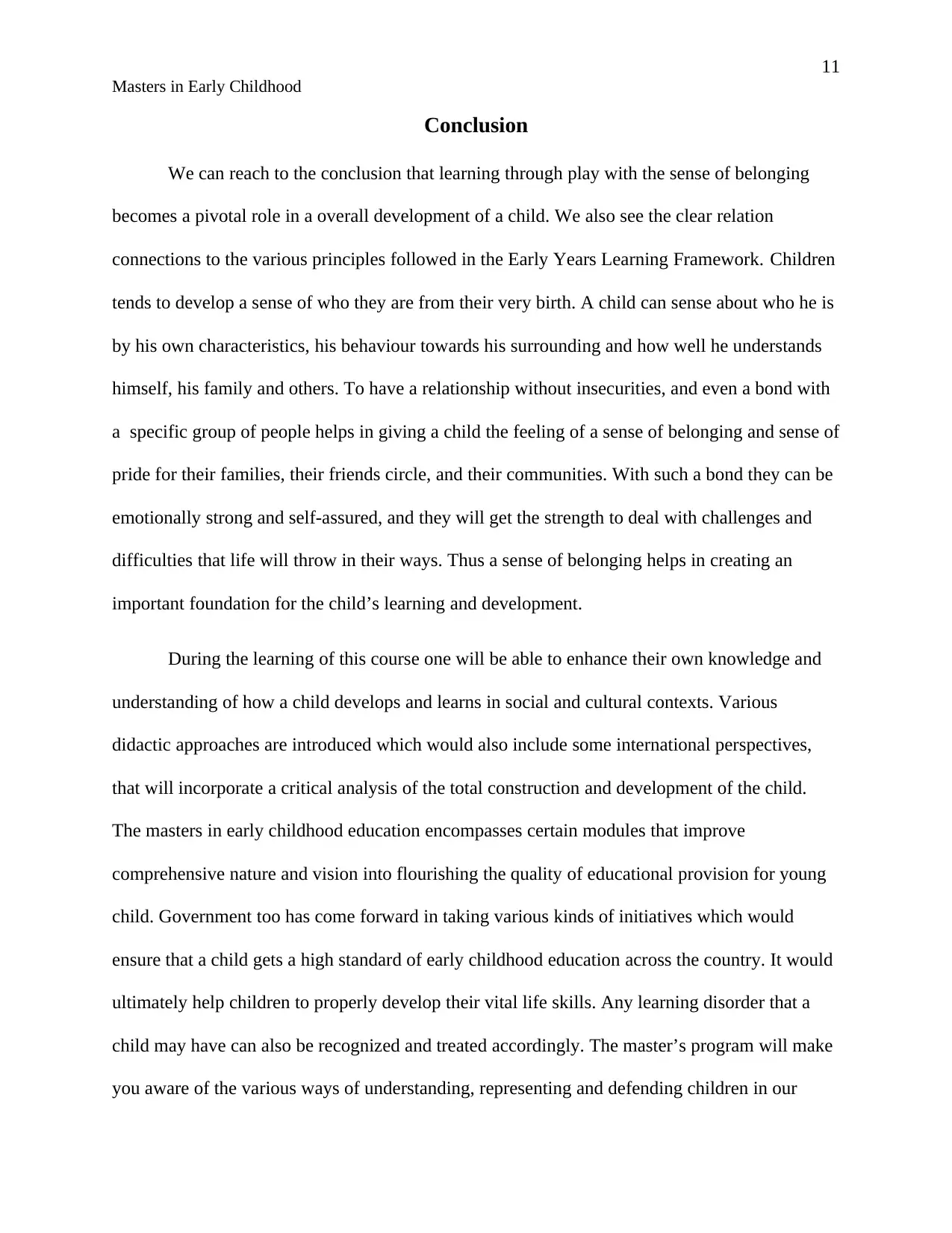
11
Masters in Early Childhood
Conclusion
We can reach to the conclusion that learning through play with the sense of belonging
becomes a pivotal role in a overall development of a child. We also see the clear relation
connections to the various principles followed in the Early Years Learning Framework. Children
tends to develop a sense of who they are from their very birth. A child can sense about who he is
by his own characteristics, his behaviour towards his surrounding and how well he understands
himself, his family and others. To have a relationship without insecurities, and even a bond with
a specific group of people helps in giving a child the feeling of a sense of belonging and sense of
pride for their families, their friends circle, and their communities. With such a bond they can be
emotionally strong and self-assured, and they will get the strength to deal with challenges and
difficulties that life will throw in their ways. Thus a sense of belonging helps in creating an
important foundation for the child’s learning and development.
During the learning of this course one will be able to enhance their own knowledge and
understanding of how a child develops and learns in social and cultural contexts. Various
didactic approaches are introduced which would also include some international perspectives,
that will incorporate a critical analysis of the total construction and development of the child.
The masters in early childhood education encompasses certain modules that improve
comprehensive nature and vision into flourishing the quality of educational provision for young
child. Government too has come forward in taking various kinds of initiatives which would
ensure that a child gets a high standard of early childhood education across the country. It would
ultimately help children to properly develop their vital life skills. Any learning disorder that a
child may have can also be recognized and treated accordingly. The master’s program will make
you aware of the various ways of understanding, representing and defending children in our
Masters in Early Childhood
Conclusion
We can reach to the conclusion that learning through play with the sense of belonging
becomes a pivotal role in a overall development of a child. We also see the clear relation
connections to the various principles followed in the Early Years Learning Framework. Children
tends to develop a sense of who they are from their very birth. A child can sense about who he is
by his own characteristics, his behaviour towards his surrounding and how well he understands
himself, his family and others. To have a relationship without insecurities, and even a bond with
a specific group of people helps in giving a child the feeling of a sense of belonging and sense of
pride for their families, their friends circle, and their communities. With such a bond they can be
emotionally strong and self-assured, and they will get the strength to deal with challenges and
difficulties that life will throw in their ways. Thus a sense of belonging helps in creating an
important foundation for the child’s learning and development.
During the learning of this course one will be able to enhance their own knowledge and
understanding of how a child develops and learns in social and cultural contexts. Various
didactic approaches are introduced which would also include some international perspectives,
that will incorporate a critical analysis of the total construction and development of the child.
The masters in early childhood education encompasses certain modules that improve
comprehensive nature and vision into flourishing the quality of educational provision for young
child. Government too has come forward in taking various kinds of initiatives which would
ensure that a child gets a high standard of early childhood education across the country. It would
ultimately help children to properly develop their vital life skills. Any learning disorder that a
child may have can also be recognized and treated accordingly. The master’s program will make
you aware of the various ways of understanding, representing and defending children in our
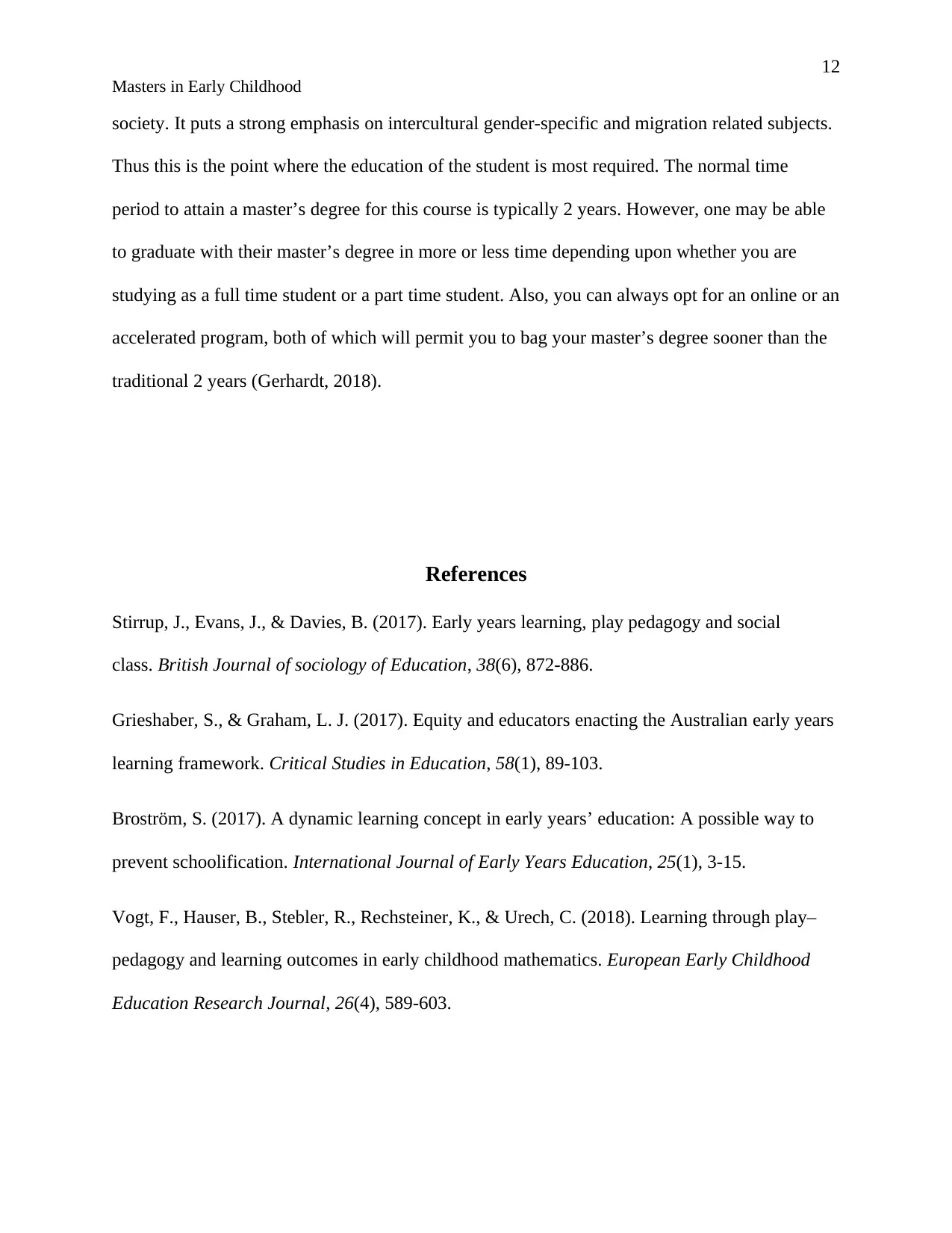
12
Masters in Early Childhood
society. It puts a strong emphasis on intercultural gender-specific and migration related subjects.
Thus this is the point where the education of the student is most required. The normal time
period to attain a master’s degree for this course is typically 2 years. However, one may be able
to graduate with their master’s degree in more or less time depending upon whether you are
studying as a full time student or a part time student. Also, you can always opt for an online or an
accelerated program, both of which will permit you to bag your master’s degree sooner than the
traditional 2 years (Gerhardt, 2018).
References
Stirrup, J., Evans, J., & Davies, B. (2017). Early years learning, play pedagogy and social
class. British Journal of sociology of Education, 38(6), 872-886.
Grieshaber, S., & Graham, L. J. (2017). Equity and educators enacting the Australian early years
learning framework. Critical Studies in Education, 58(1), 89-103.
Broström, S. (2017). A dynamic learning concept in early years’ education: A possible way to
prevent schoolification. International Journal of Early Years Education, 25(1), 3-15.
Vogt, F., Hauser, B., Stebler, R., Rechsteiner, K., & Urech, C. (2018). Learning through play–
pedagogy and learning outcomes in early childhood mathematics. European Early Childhood
Education Research Journal, 26(4), 589-603.
Masters in Early Childhood
society. It puts a strong emphasis on intercultural gender-specific and migration related subjects.
Thus this is the point where the education of the student is most required. The normal time
period to attain a master’s degree for this course is typically 2 years. However, one may be able
to graduate with their master’s degree in more or less time depending upon whether you are
studying as a full time student or a part time student. Also, you can always opt for an online or an
accelerated program, both of which will permit you to bag your master’s degree sooner than the
traditional 2 years (Gerhardt, 2018).
References
Stirrup, J., Evans, J., & Davies, B. (2017). Early years learning, play pedagogy and social
class. British Journal of sociology of Education, 38(6), 872-886.
Grieshaber, S., & Graham, L. J. (2017). Equity and educators enacting the Australian early years
learning framework. Critical Studies in Education, 58(1), 89-103.
Broström, S. (2017). A dynamic learning concept in early years’ education: A possible way to
prevent schoolification. International Journal of Early Years Education, 25(1), 3-15.
Vogt, F., Hauser, B., Stebler, R., Rechsteiner, K., & Urech, C. (2018). Learning through play–
pedagogy and learning outcomes in early childhood mathematics. European Early Childhood
Education Research Journal, 26(4), 589-603.
⊘ This is a preview!⊘
Do you want full access?
Subscribe today to unlock all pages.

Trusted by 1+ million students worldwide
1 out of 13
Related Documents
Your All-in-One AI-Powered Toolkit for Academic Success.
+13062052269
info@desklib.com
Available 24*7 on WhatsApp / Email
![[object Object]](/_next/static/media/star-bottom.7253800d.svg)
Unlock your academic potential
Copyright © 2020–2025 A2Z Services. All Rights Reserved. Developed and managed by ZUCOL.




